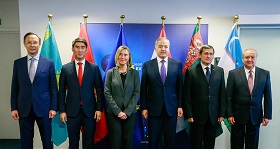The EU and Russia, despite their differences in some parts of the world, can find ways to cooperate on mutually beneficial projects in Central Asia. Unifying issues between the two powers include fighting drug trafficking flowing from Afghanistan, reducing religious extremism and terrorism, and counteracting regional ecological concerns such as water security that could cause a major refugee crisis.
The main challenge is to overcome their rivalry and find ways of developing joint initiatives in light of common strategic goals.
The EU strategy in Central Asia
First, it is important to remember that the EU has a short history of relations with Central Asia. Its strategy towards the region was first introduced in 2007 and reviewed in 2015. It is less ambitious compared to the EU policy towards the six Eastern Neighborhood countries showing that, despite the strategic importance of Central Asia, the European Union prioritizes geographically closer regions.
The 2007 document, named “The EU and Central Asia: Strategy for a New Partnership,” designed during the German presidency of the Council of the European Union, gave an essential push to the relations between the EU and Central Asia. It outlined four main motives behind the EU’s interests. First, the developments in the region influence the EU itself; second, Central Asia has become increasingly close to the EU in light of the subsequent rounds of enlargement and the establishment of the Eastern Neighborhood Policy; third, Central Asia’s goal to diversify its energy export markets matches with the EU’s aim to diversify its energy imports and finally, the common need to fight terrorism, especially in unstable regions like Afghanistan. In 2007, Central Asia also attracted much attention due to air-bases built in Kyrgyzstan and Uzbekistan, which helped the U.S. and its allies in transporting goods and troops to Afghanistan. Therefore, the region started to be seen as a significant security partner for the international coalition. The 2007 EU Strategy in Central Asia focused almost entirely on typical soft power goals, such as the promotion of democracy, human rights and rule of law. The EU’s initial interest in Central Asia was based to a large degree on energy security issues. From 2007 to 2010, the EU aimed at starting to import gas from the Caspian and Central Asia (via the Nabucco pipeline, for instance), though this project proved to be a failure.
More recently the EU’s attention switched towards traditional security issues. This is linked to the 2014 withdrawal of NATO from Afghanistan and to the understanding that in order to play a significant role in Central Asia, the EU should engage in security matters similar to other key regional actors (China, Russia, the United States). Because of these reasons, a second official strategy in Central Asia was designed. It shows that the EU began to engage in Central Asia not only on soft security issues such as migration or poverty reduction but also and most importantly on hard security issues, such as organized crime and terrorism. Among the introduced measures, there was the establishment of an EU-Central Asia High-Level Security Dialogue and EU support in fortifying Central Asian countries’ borders with Afghanistan. It is worth noticing that the focus on traditional security issues, and therefore global power competition, is not a common approach of the EU, which typically focuses mainly on normative power.
The 2019 revised EU strategy in Central Asia aims at redefining the policy towards the region in light of its evolved geopolitical landscape. Interestingly, hard security issues will be given even more centrality. However, the strategy is based on both a realistic approach aimed at achieving “realpolitik” goals, such as energy diversification and regional security and on a soft-policy agenda to promote greater commitments in the fields of education, healthcare, borders and civil society.
It is interesting to notice that the European Union’s member states have diverging perceptions of their interests in Central Asia. Germany, Italy, and France in particular, support a utilitarian approach to Central Asia, based on economic and energy cooperation, while Northern European countries aim at fostering a value-based agenda.
Russia’s Strategy in Central Asia
The Russian strategy towards Central Asia has included military-technological cooperation, energy projects, and the strengthening of the Eurasian Economic Union’s institutions.
It is worth considering that Russia does not have an official document outlining its strategy towards Central Asia. Experts have an opposing view on that: some of them see such a document as unnecessary, while others consider its absence as a policy problem. However, Moscow has not been able to develop a comprehensive and long term policy towards Central Asia.
Despite the aforementioned issues, it is clear that Central Asia is seen as a strategic region by Russia, crucial to ensure its defense and great power status. Moscow still represents the most influential actor in the area from a political, economic and military point of view. Soft power is also exercised, due to the widespread use of the Russian language and media in the region.
Russian strategy in central Asia can be interpreted from a realist point of view. Central Asia represents a key geostrategic area to influence and control huge energy resources.
Moreover, it is part of the privileged spheres of influence claimed by the Kremlin, thus being central to balance power among the other actors involved in the region. The Russian policy of “energy-super state” was probably introduced to describe Moscow’s will to take advantage of its dominant position in the energy market to raise its international influence. This convergence of Russia’s energy and foreign policy is consistent with the premises of political realism, which supports the use of domestic power in foreign affairs to pursue national interests. Clearly, natural resources represent an essential element of national power.
Potential for EU-Russia cooperation in Central Asia
Differently from other areas of the post-Soviet space, where European and Russian interests are in open competition, Central Asia may become a region of cooperation in light of common, shared aims.
Since the 2014 Ukraine crisis, both Russia and the EU have reiterated their goals and priorities in Central Asia. Moscow sees in a distrustful way the EU’s attempts to promote democracy, human rights and rule of law in the region, fearing the destabilization of existing regimes and waves of color revolutions. Moreover, significant differences exist in how Brussels and Moscow see the energy domain. Russia and the EU have a contrasting view on how the Turkmen gas should reach Europe: whether through Russia or Turkey or Azerbaijan. However, since China has become the major customer for Central Asia’s energy, Russian interest in Turkmen gas has decreased, and the prospects for the EU’s plans to build any gas pipeline has decreased too. Therefore, the issue is not likely to create tensions between Brussels and Moscow.
Despite the contrasts, it is crucial to notice that European and Russian objectives in the region are not in direct competition. Thus, despite the lack of trust, there are some areas where Russia and the EU can collaborate.
The first one is connected with shared security concerns. Both the EU and Russia aim at fighting drug trade (which originates from Afghanistan and transits through Central Asia to Russia and Europe), terrorism, and instability. Moreover, Central Asian states are looking for diversifying their foreign policy, cultivating relations with all the major global and regional powers. These goals are achievable through EU-Russia cooperation. Furthermore, in 2015 a joint fund of 25 million dollars was established with the UNDP to finance several projects in Central Asia. This represents a clear space of cooperation between the EU and Russia.
***
The European Union and Russian influence in Central Asia are deeply different. The region does not represent a priority for Brussels if compared to geographically closer neighbors. The EU strategy towards Central Asia deals with soft-security goals, as well as hard-security aims, introduced more recently. The EU is an important provider of development aid, but at the same time is perceived to have low visibility in the region.
Russia, on the contrary, is the most influential actor in Central Asia, and its agenda is based on the respective ruling regimes’ stability to avoid significant disruptions.
Stability is a recurrent word in many documents, both European and Russian. The EU Central Asia Strategy focuses on security and stability as major priorities. The Russian foreign policy concept draws attention to rising threats of terrorism, extremism, and drug-trafficking stemming from Afghanistan. The EU and Russia have, however, different understandings of how stability is achieved. The EU links this latter goal to the development of a democratic and economically successful Central Asia. It is proof of the normative nature of the EU foreign policy, which interprets democracy, human rights and rule of law as central elements to achieve long-term stability and security. On the contrary, Russia’s approach to guarantee long-lasting stability and security in Central Asia is mainly connected to the support of the region’s regimes.
Despite the differences mentioned above and lack of trust, there are certain areas where Moscow and Brussels can cooperate in Central Asia. Primarily, they may act together on security issues such as fighting drug trafficking and containing extremism that can stem from Afghanistan. The EU and Russia share a certain degree of agreement on which issues are essential to preserve security in Central Asia. Both aim at strengthening the ability of the local government in fighting extremism and Islamic militants. Moreover, Moscow and Brussels maintain that major regional challenges are the depletion of water resources and ecological problems that may cause dangerous waves of mass migration. The EU and Russia may cooperate to prevent these issues turning into significant sources of destabilization, economic and social crises, being both interested in avoiding this outcome. The main challenge is to overcome their rivalry and find ways of developing joint initiatives in light of common strategic goals.







